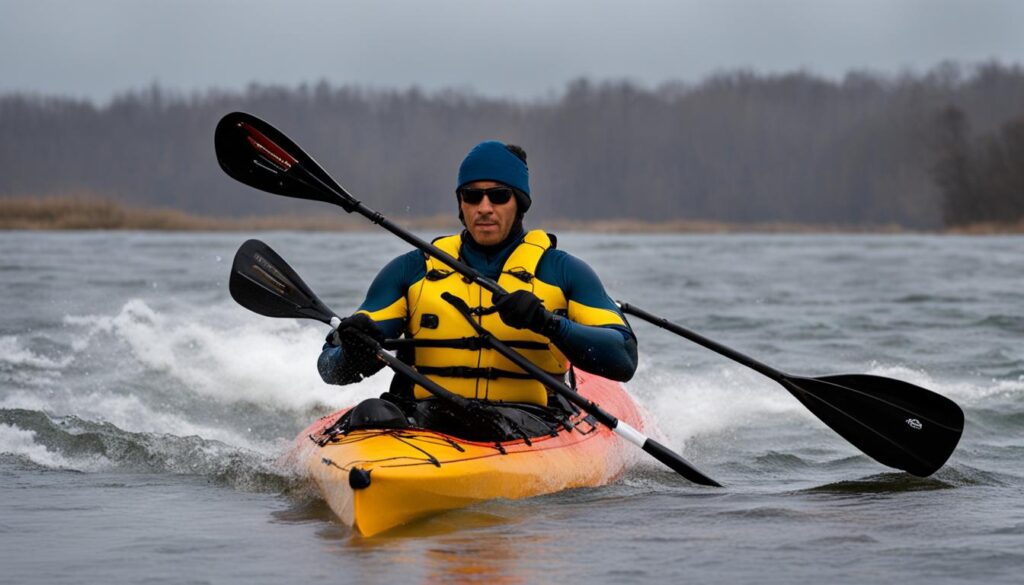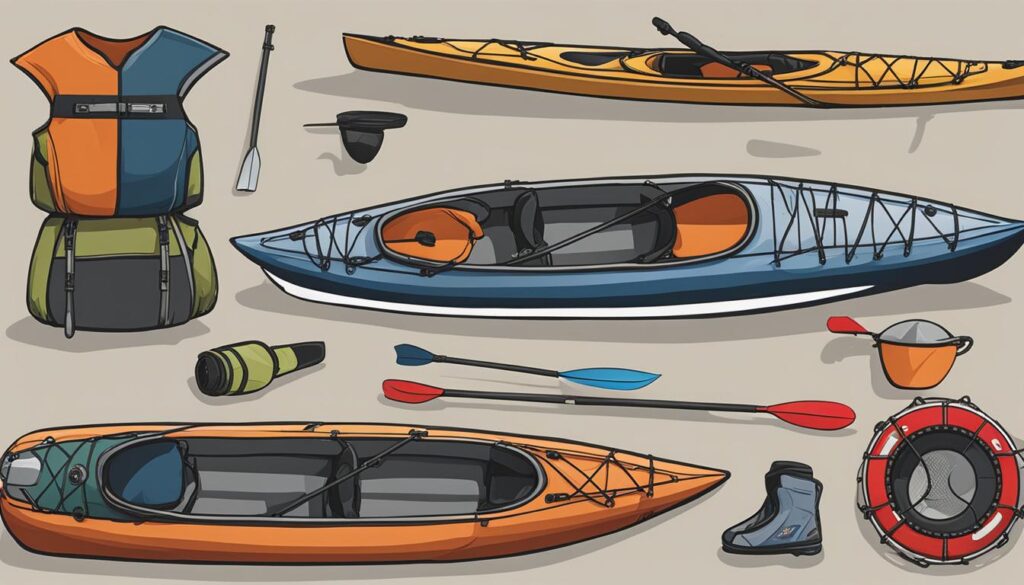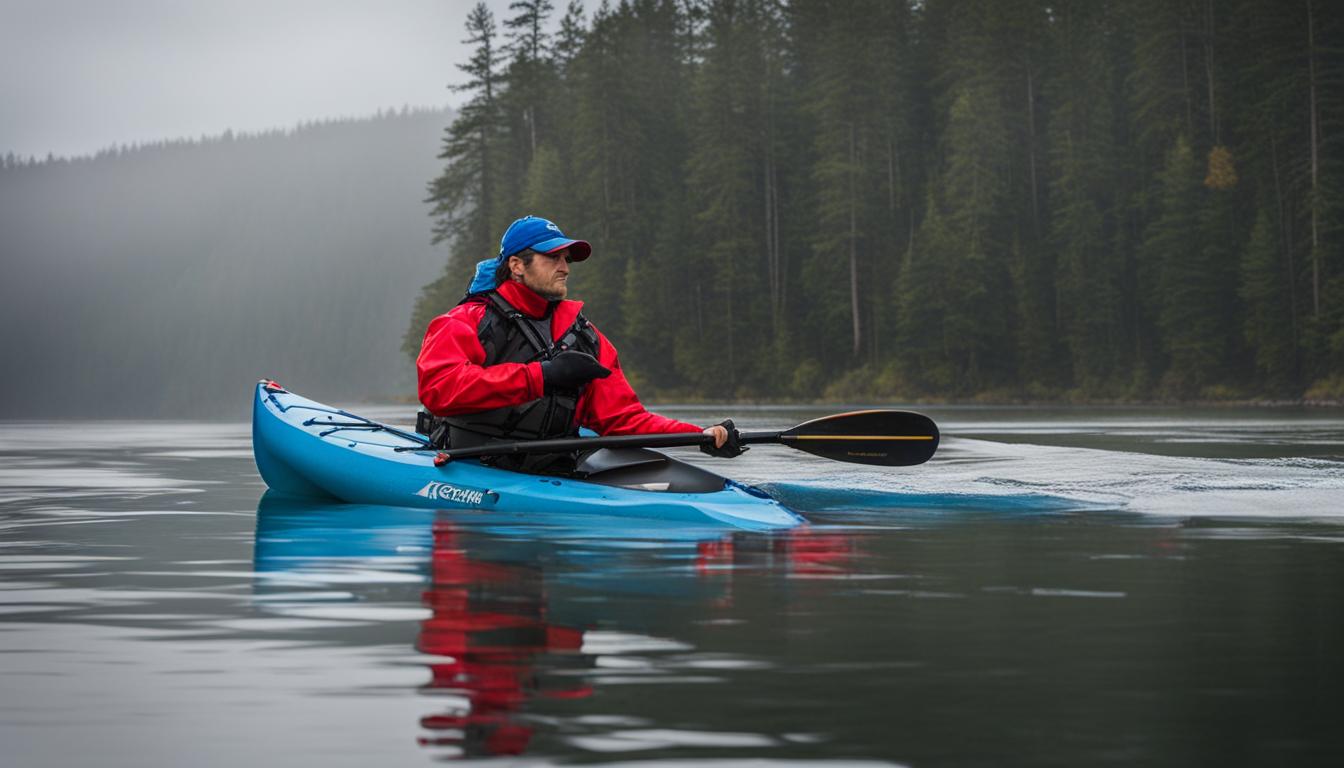Knowing what to wear kayaking is essential for a safe and comfortable experience. Whether you’re paddling in hot summer temperatures or braving freezing winter conditions, having the right kayaking attire is crucial. In this article, we will explore how to dress appropriately for various weather conditions and provide tips on adjusting your kayak outfit to ensure a pleasant paddling experience.
Key Takeaways:
- Research the weather conditions and water temperatures before your kayaking trip.
- Choose clothing suitable for the climate and type of paddling you’ll be doing.
- Dress in layers and prioritize quick-drying and high-wicking materials.
- Consider the type of kayak you’ll be using and its impact on your clothing choices.
- Select suitable footwear, such as neoprene boots or fast-drying shoes.
Dress for the Conditions
When it comes to kayaking, dressing appropriately for the conditions is key to ensuring a comfortable and enjoyable experience. A well-prepared kayaker understands the importance of checking the weather forecasts for their paddling area and packing the right clothing to suit the environment. Whether you’re kayaking in spring, summer, fall, or winter, having versatile kayaking apparel is crucial to adapting to different seasons.
One of the best ways to dress for kayaking is by layering your clothing. This allows you to adjust your attire according to your level of physical exertion and the changing weather conditions. Start with a moisture-wicking base layer that will keep you dry and comfortable. Add a mid-layer for insulation, and top it off with a waterproof and windproof outer layer to protect you from the elements. Dressing in layers also provides the flexibility to remove or add clothing as needed.
Another important consideration is the type of paddling you’ll be doing. Different types of kayaking, such as whitewater kayaking or touring kayaking, require specific clothing choices. Whitewater kayakers may opt for more durable and impact-resistant attire, while touring kayakers may prioritize lightweight and breathable clothing. Understanding the demands of your chosen paddling activity will help you select the right gear for the conditions.
| Season | Essential Clothing |
|---|---|
| Spring | Wetsuit or drysuit, moisture-wicking base layers, waterproof outer layer |
| Summer | Quick-drying shorts or swimsuit, rash guard or moisture-wicking top, sun protection |
| Fall | Lightweight wetsuit or drysuit, layering options for changing weather conditions |
| Winter | Drysuit, thermal base layers, insulating mid-layers, waterproof gloves and footwear |
Remember, the key to dressing right for kayaking is to be prepared and adaptable. Keep an eye on the weather forecast and pack clothing that will keep you comfortable and protected. With the right kayaking attire, you can enjoy your paddling adventures in any season and weather condition.
Quote:
“Dressing appropriately for kayaking is not just about fashion, it’s about comfort and safety. Being prepared for the conditions you’ll be facing will ensure you have a great time on the water.”

Sources:
- https://www.paddling.com/learn/dress-for-kayaking/
- https://www.rei.com/learn/expert-advice/kayaking-clothing.html
- https://www.westcoastpaddler.com/community/threads/getting-into-kayaking-and-selected-the-right-clothing.7430/
Research the Weather Conditions
Before embarking on your kayaking adventure, it’s crucial to research the weather conditions for the area you’ll be paddling in. Knowing the current weather and water temperatures will help you choose the appropriate clothing and gear for your journey. Keep in mind that weather conditions can change rapidly, so it’s essential to stay updated before and during your trip.
Start by checking the weather forecasts for your kayaking location. Look for information on temperature, wind speed, and precipitation. This will give you a general idea of what to expect during your excursion. But don’t stop there – it’s also important to consider the specific conditions of the river or sea you’ll be kayaking on.
For river kayaking, be aware that upstream conditions can significantly impact the water you’ll be paddling on. Heavy rain or melting snow upstream can cause water levels to rise rapidly, creating strong currents and potentially hazardous conditions. Similarly, for sea kayaking, researching coastal water conditions is essential, as tides, currents, and wind patterns can vary greatly from one area to another.
Armed with this knowledge, you’ll be better prepared for the situational conditions you may encounter during your kayaking trip. By researching the weather conditions, you can increase your safety and enjoyment on the water.
Consider the Type of Paddling
When it comes to kayaking, the type of paddling you’ll be doing is an important factor to consider when choosing your gear and clothing. Different paddling types require different attire to ensure your comfort and safety throughout your adventure.
If you’re planning on engaging in whitewater kayaking, it’s crucial to have the right clothing that can handle the intense conditions. Wear a wetsuit or a drysuit, depending on the water temperature, to keep yourself warm and protected. Additionally, consider wearing a helmet and other protective gear to ensure your safety.
On the other hand, if you’re going on a relaxed touring trip, you can opt for more versatile clothing options. Layering is key here, as it allows you to adjust your outfit based on the weather conditions. Start with a moisture-wicking base layer, add an insulating mid-layer, and finish with a waterproof outer layer to protect yourself from any unexpected rain or splashes.
Layering Strategies for Kayaking
In general, layering is a great strategy to stay comfortable during your kayaking adventures. It allows you to add or remove layers as needed, depending on the temperature and weather conditions. Here are some tips for effective layering:
- Start with a moisture-wicking base layer to keep sweat away from your skin and maintain your body temperature.
- Add an insulating mid-layer, such as a fleece or wool sweater, to provide extra warmth.
- Finish with a waterproof and windproof outer layer, like a paddling jacket or dry top, to protect yourself from water and wind.
By following these layering strategies and considering the type of paddling you’ll be doing, you’ll be able to choose the right gear and clothing for your kayaking adventures, ensuring a comfortable and enjoyable experience.

Choose the Right Type of Kayak
When it comes to selecting the right kayak for your kayaking adventure, it’s important to consider the type of kayak that best suits your needs and the weather conditions you’ll be facing.
Sit-In Kayaks
Sit-in kayaks offer more protection from the elements compared to sit-on-top kayaks. They have a cockpit that you sit inside, providing better insulation and shielding you from wind, splash, and rain. This makes sit-in kayaks a great choice for colder weather conditions or when paddling in rougher waters. With the use of spray skirts, you can further protect yourself from water entering the cockpit, keeping you dry and comfortable.
Sit-On-Top Kayaks
On the other hand, sit-on-top kayaks provide a more open and breathable experience. These kayaks are ideal for warmer weather or when paddling in calm waters. Sit-on-top kayaks allow for greater airflow, keeping you cool and preventing overheating. However, it’s important to note that sit-on-top kayaks do result in a wetter experience, as water can splash onto you more easily. So, if you’re paddling in colder temperatures or rougher waters, you may need to adjust your attire and choose clothing that provides better insulation.
Ultimately, the choice between a sit-in kayak and a sit-on-top kayak depends on your personal preference, the weather conditions, and the level of protection you desire. Consider the climate and conditions you’ll be kayaking in and select the type of kayak that best suits your needs. Adapt your kayaking attire accordingly to ensure a comfortable and enjoyable experience on the water.
Select Suitable Footwear
Choosing the right footwear for kayaking is essential for comfort and safety. Whether you’re paddling in cold or warm water, having the appropriate shoes can make a significant difference in your overall experience. Here are some options to consider when selecting footwear for kayaking:
- Neoprene boots: Neoprene boots provide insulation and protection in colder water. They are designed to keep your feet warm and dry, even in freezing temperatures. These boots are a popular choice for kayakers who venture out in colder climates.
- Water shoes: Water shoes are lightweight and quick-drying, making them ideal for warmer waters. They provide protection against rocks, shells, and other debris in the water while allowing your feet to breathe. Water shoes are a versatile option for kayakers who paddle in various weather conditions.
- Neoprene booties and socks: Neoprene booties and socks can be worn with water shoes or on their own. They add an extra layer of insulation and protection to keep your feet warm and comfortable in cold water.
When choosing footwear for kayaking, it’s important to consider the water temperature, weather conditions, and the type of kayaking you’ll be doing. Additionally, look for shoes with a chunky rubberized sole that provides excellent grip on wet surfaces, ensuring your safety while navigating in and out of the water.
Comparison of Kayaking Footwear
| Footwear | Features | Pros | Cons |
|---|---|---|---|
| Neoprene Boots | Insulation, protection against cold water | – Provides warmth in freezing temperatures – Offers excellent protection against rocks and debris |
– May be less breathable in warmer weather – Heavier than other options |
| Water Shoes | Lightweight, quick-drying | – Breathable and comfortable in warm weather – Versatile for different climates |
– Less insulation in cold water – May provide less protection against sharp objects |
| Neoprene Booties and Socks | Added insulation and protection | – Enhances warmth in cold water – Can be worn with water shoes or on their own |
– May require additional maintenance and care – Less protection compared to neoprene boots |
Remember to choose footwear that is comfortable, fits properly, and suits the specific conditions of your kayaking adventure. Taking care of your feet is essential for enjoying every moment on the water.
Kayaking in Cold Weather
When embarking on a kayaking adventure in cold weather, it’s crucial to prioritize your safety and comfort by dressing appropriately. The frigid temperatures and icy waters pose unique challenges that require specialized kayaking clothing for winter conditions. By following these essential tips, you can ensure an enjoyable and safe experience on the water.
Layer Up for Warmth
Layering is key when it comes to kayaking in freezing temperatures. Start with a thermal base layer that wicks away sweat and keeps you warm. Over this, add a mid-layer made of insulating materials like fleece or wool. This layer traps heat and provides extra insulation. Finally, top it off with a drysuit, which acts as a final barrier against the cold elements. The drysuit should be fully waterproof and offer excellent insulation properties.
Protect Your Extremities
In cold weather, it’s crucial to protect your extremities from frostbite. Wear thermal hats or buffs to cover your head and neck, reducing heat loss from these areas. Don’t forget about your hands; consider using pogies, which are specialized hand covers designed for kayaking. These allow you to maintain dexterity while keeping your hands warm and protected. Additionally, invest in thermal socks and waterproof gloves for added warmth and comfort.
Bring a Spare Set of Clothes
Even with the best preparation, there’s always a chance of getting wet during kayaking. In cold weather, this can quickly lead to hypothermia if you’re not adequately dressed. To be prepared for any situation, pack a spare set of dry clothes in a waterproof bag. This way, if you do get wet, you can change into warm and dry clothing to prevent further heat loss and stay comfortable throughout your kayaking trip.
| Essential Kayaking Clothing for Cold Weather | Features |
|---|---|
| Thermal Base Layer | Moisture-wicking, insulating fabric |
| Insulating Mid-Layer | Fleece or wool material for added warmth |
| Drysuit | Fully waterproof, excellent insulation |
| Thermal Hat or Buff | Protects head and neck from heat loss |
| Pogies | Hand covers for warmth and dexterity |
| Thermal Socks | Keeps feet warm and protected |
| Waterproof Gloves | Provides warmth and protection |
By wearing the proper kayaking clothing for winter conditions and taking precautions to protect your extremities, you can enjoy kayaking in cold weather without compromising your comfort and safety. Remember to always check weather forecasts and water conditions before your trip and adjust your clothing accordingly. Stay warm, stay safe, and have a fantastic time exploring the beautiful winter landscapes from your kayak.
Conclusion
Dressing appropriately for kayaking is crucial for both your comfort and safety. By considering the weather and water temperatures, as well as the type of paddling and kayak you’ll be using, you can ensure a more enjoyable experience on the water. Here are some final tips to keep in mind:
Weather Adaptive Kayaking Gear
Invest in clothing and gear that can adapt to changing weather conditions. Dress in layers so you can easily adjust to temperature changes throughout your trip. Choose materials that are quick-drying and high-wicking to keep you comfortable even if you get wet.
Dressing for Kayak Temperature Changes
Anticipate changes in water temperature by bringing appropriate clothing. If you’ll be paddling in cold water, consider investing in a drysuit for total waterproofing and insulation. Layer thermal base and mid-layers to stay warm, and don’t forget to protect your extremities with pogies, thermal hats, buffs, or face masks.
Kayak Clothing Tips
Always pack a spare set of clothes, especially if there’s a chance of immersion. Stay updated on weather and water conditions to make informed clothing choices. And finally, don’t forget to wear suitable footwear for kayaking. Neoprene boots provide insulation in cold water, while fast-drying shoes are ideal for warmer conditions.
With these tips in mind, you’ll be well-prepared to dress right for your kayaking adventures. Stay safe, stay comfortable, and enjoy your time on the water!
FAQ
What should I wear for kayaking?
Dress appropriately for the weather conditions and water temperatures. Choose clothing that is high-wicking and suitable for your activity. Dress in layers and consider the type of paddling you’ll be doing and the kayak you’ll be using.
How can I anticipate the weather conditions for kayaking?
Research the weather forecasts for your paddling area before your trip. Check not only the current weather but also the water temperatures. Consider upstream conditions for river kayaking and coastal water conditions for sea kayaking.
Does the type of paddling affect my attire?
Yes, the type of paddling you’ll be doing plays a significant role in determining your clothing choices. Whitewater kayaking requires different clothing compared to touring kayaking. Analyze the conditions you’ll encounter along your journey to choose the appropriate clothing.
How does the type of kayak impact what I wear?
The type of kayak you’ll be using affects your clothing choices. Sit-on-top kayaks provide greater ventilation but result in a wetter experience. Sit-in kayaks offer more protection and allow for the use of spray skirts. Consider the climate and conditions you’ll be kayaking in before deciding which type of kayak to use.
What kind of footwear should I wear for kayaking?
Neoprene boots provide insulation in cold water, while fast-drying shoes are ideal for warmer waters. Neoprene booties and socks can keep your feet warm and protected. Look for shoes with a chunky rubberized sole for better grip on wet surfaces.
How should I dress for kayaking in cold weather?
For cold weather kayaking, a drysuit is the best option for total waterproofing and insulation. Pair the drysuit with thermal base and mid-layers to stay warm. Consider wearing pogies, thermal hats, buffs, or face masks to protect your extremities from the cold. Dress in layers and bring a spare set of clothes in case of immersion.
Why is dressing appropriately for kayaking important?
Dressing appropriately for kayaking is crucial for comfort and safety. Anticipating the conditions you’ll be facing and choosing the right clothing helps ensure a safe and enjoyable experience on the water.





